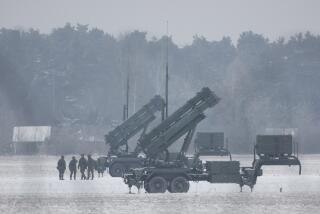Putting a Price Tag on War Proves to Be a Battle in Itself
- Share via
WASHINGTON — The challenge of estimating the cost of the Persian Gulf War seems to prove the old saw that if you stacked all the economists in the country end-to-end, they wouldn’t come to a conclusion.
The question of what the eight-month crisis actually cost the U.S. Treasury is important not only for federal budget-makers but for taxpayers and a host of allied governments. Yet the experts disagree wildly.
By some estimates, Uncle Sam may be about to turn a profit on Operation Desert Storm.
ALL-OUT EFFORT: The Bush Administration, fearful that war costs would send the federal budget spinning out of control, launched an all-out effort to prod major allies into picking up part of the tab. Eventually, it rounded up pledges totaling $53 billion.
The Congressional Budget Office estimates that the war cost only $40 billion--$13 billion less than the allies have pledged. That would leave Uncle Sam with a tidy--and somewhat embarrassing--profit.
That prospect led Germany’s opposition Social Democrats to urge the Bonn government not to pay the $6 billion it had promised. (The ruling Christian Democrats rejected the suggestion.)
And Lawrence J. Korb, a Defense Department official during the Ronald Reagan Administration, charged that the Pentagon had been trying to use the allied contributions to offset broader cuts in the military budget that Congress had ordered.
“If we want our allies to fund the war in full or pay us for spilling our blood, we ought to say so,” Korb wrote on the op-ed page of the New York Times.
But whether the allies are being asked to pay too much--or too little--depends on what the war cost. And that is a very difficult number to determine.
The reason is that tallying the cost of the war demands a clear definition of which expenses should be counted.
While the CBO estimate is $40 billion, the Pentagon has told Congress that by the time American forces all are home, the Gulf War operation will likely cost at least $60 billion more than normal military spending.
The General Accounting Office, the investigative arm of Congress, estimates the total at about $100 billion.
And Budget Director Richard G. Darman reckons that the U.S. spent $31.5 billion on Operation Desert Storm and warns that the tab could mushroom to $60 billion when the costs of bringing the troops back are counted in.
Moreover, Darman cautions, that doesn’t count the cost of repairing or rehabilitating equipment that was damaged in combat. And he estimates that it could cost $12 billion or so more to maintain U.S. troops in the region during an orderly withdrawal.
Sean O’Keefe, the Pentagon’s comptroller, says the United States has received about $39 billion of the $53 billion in pledges. Saudi Arabia still owes about $9.2 billion of its $16.8-billion pledge, and Kuwait owes $6.7 billion out of $16 billion.
ADDING IT UP: But, as the Pentagon’s O’Keefe points out, the truth is in the eye of the accountant:
The Congressional Budget Office estimate of $40 billion, for example, doesn’t count the cost of getting U.S. troops home--or replacing materiel.
The GAO’s $100-billion tally includes the cost of operating U.S. forces in the Gulf region, even though they would have been paid if there had been no war. It also counts the cost of forgiving about $7 billion in U.S. loans to Egypt--a reward for Cairo’s participation in the Gulf force.
By contrast, the Pentagon’s total counts only so-called incremental charges--such as extra combat pay, additional flying and ship-steaming hours and replacement of ammunition and equipment.
Even so, it is unlikely anyone in Washington will rush to square the record soon. “Especially where someone else is paying,” one key Capitol Hill staffer says, “people here ask themselves why we should make extraordinary levels of effort to check the figures.”
More to Read
Sign up for Essential California
The most important California stories and recommendations in your inbox every morning.
You may occasionally receive promotional content from the Los Angeles Times.













